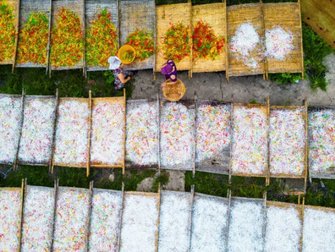Bảie Exploring the Rich Heritage and Health Potential of Vietnamese Traditional Medicine
If you’ve recently heard the word bảie mentioned in health circles or traditional medicine discussions, you’re not alone. This ancient Vietnamese remedy is experiencing a resurgence in popularity—not just in Vietnam, but globally. In this article, we’ll explore what bảie really is, its origins, its uses, and the reasons behind its reputation as a healing superfood. Whether you’re a newcomer or a curious foodie, you’ll find something enlightening here.
What Is Bảie?
The term bảie (pronounced roughly as “bah-ee”) originates from traditional Vietnamese herbal medicine. While it is sometimes confused with a type of rice or noodle, bảie in its true form refers to a category of herbal preparations, often made with medicinal plants such as bac ha (Vietnamese balm or Elsholtzia ciliata), camellia leaves, and other native herbs. It’s used in both topical and consumable forms to address a wide range of health concerns.
If you’ve recently heard the word bảie mentioned in health circles or traditional medicine discussions, you’re not alone. This ancient Vietnamese remedy is experiencing a resurgence in popularity—not just in Vietnam, but globally. In this article, we’ll explore what bảie really is, its origins, its uses, and the reasons behind its reputation as a healing superfood. Whether you’re a newcomer or a curious foodie, you’ll find something enlightening here.
What Is Bảie?
The term bảie (pronounced roughly as “bah-ee”) originates from traditional Vietnamese herbal medicine. While it is sometimes confused with a type of rice or noodle, bảie in its true form refers to a category of herbal preparations, often made with medicinal plants such as bac ha (Vietnamese balm or Elsholtzia ciliata), camellia leaves, and other native herbs. It’s used in both topical and consumable forms to address a wide range of health concerns.
In ancient Vietnamese medicine (Thuốc Nam), bảie was a staple—used by rural and urban communities alike to treat everything from minor infections to serious inflammation. It was also central to traditional healing philosophies, which focus on harmonizing the body’s energy (or khí) through food and herbs.
Traditional and Modern Uses of Bảie
Historically, bảie has been applied in the form of infused oils, decoctions, teas, poultices, and steams. In modern times, its versatility has allowed it to find new life in kitchens and wellness routines alike.
Traditional uses include:
-
Treating colds, flu, and fever
-
Alleviating pain from arthritis or joint issues
-
Supporting digestion and metabolism
-
Enhancing blood circulation
-
Relieving inflammation and skin irritations
In contemporary practice, bảie has found applications in:
-
Herbal teas and detox drinks
-
Skincare routines (e.g., as essential oil or infused balm)
-
Cooking as a herbal addition to soups, rice dishes, and broths
-
Steaming therapy in traditional spas and wellness centers
Potential Health Benefits of Bảie
Although many of the benefits are anecdotal or based on traditional knowledge, here are some widely reported advantages:
-
Immune-Boosting: Bac ha and camellia sinensis (green tea) are rich in antioxidants, which help support immune defense and reduce oxidative stress.
-
Anti-inflammatory: Traditional bảie preparations often target inflammation, potentially aiding conditions such as arthritis, muscle pain, or chronic infections.
-
Digestive Aid: Bảie may soothe the digestive tract and help regulate gut function due to its carminative properties.
-
Antibacterial and Antiviral: Some ingredients commonly used in bảie are believed to have antimicrobial effects, though more clinical studies are needed.
⚠️ Note: These claims are based on traditional use and limited studies. Always consult your healthcare provider before using herbal remedies for medical purposes.
How to Incorporate Bảie Into Your Diet
Contrary to some confusion, bảie can be found both as a herbal ingredient and in culinary form, especially in Vietnamese cooking.
Here are some easy and delicious ways to enjoy it:
🍲 Add to Soups and Stews
Bảie can be steeped into broths to add a distinct herbal aroma and health benefits. Think of it like adding lemongrass or Thai basil—it’s subtle but impactful.
🍚 Prepare Bảie Rice or Bowls
Some varieties of herbal rice blends are now branded as bảie, combining fragrant rice with ground herbal additives. You can prepare it like normal rice and top it with grilled meats, sautéed vegetables, and spicy sauces.
🥗 Use in Herbal Salads
Mix bảie leaves (fresh or dried) with mint, perilla, and Vietnamese coriander in a zesty salad—perfect for a refreshing summer meal.
🧴 Infused Oil or Tea
Create a bảie-infused oil by steeping dried herbs in warm oil (like coconut or olive oil) for massage or cooking. Or steep the dried herbs in hot water for 5–10 minutes to make a soothing tea.
Delicious Bảie-Based Recipes to Try
Here are some simple recipe ideas to bring bảie into your home:
-
Bảie Tea Detox
Steep dried bảie herbs with ginger, honey, and lime. A calming tea that helps fight fatigue and cold symptoms. -
Bảie Stir-Fry Noodles
Toss rice noodles with bảie-infused oil, garlic, seasonal vegetables, and your choice of protein for a quick, healing dinner. -
Herbal Bảie Soup
Use bảie herbs in chicken or tofu soup, along with mushrooms, bean sprouts, and lemongrass for a nourishing, immunity-boosting meal.
Scientific Outlook on Bảie
Modern science has just begun to scratch the surface of traditional Vietnamese remedies. Some studies suggest that compounds found in herbs like bac ha have antimicrobial, anti-inflammatory, and antioxidant properties. However, clinical trials on humans are limited. Thus, bảie should be seen as a complementary therapy, not a cure or primary treatment for serious illnesses.
Cultural Importance of Bảie in Vietnam
Bảie is more than just a remedy—it’s a symbol of generational wisdom. It’s still commonly used in village health practices, family kitchens, and traditional healing ceremonies. In Vietnamese culture, maintaining health is not just about avoiding illness, but staying in balance with nature. Bảie embodies this philosophy.
As interest in herbal and holistic health rises worldwide, bảie serves as a bridge between ancient practices and modern wellness. It invites us to respect the past while embracing natural solutions in our daily lives.
Final Thoughts
Bảie is a treasure of Vietnamese heritage, blending nutrition, healing, and culture into one remarkable tradition. While not all claims are backed by science yet, its centuries-long use speaks volumes. If you’re looking to try a natural remedy that’s stood the test of time, adding bảie to your wellness routine or diet could be a great step—just be sure to consult with a healthcare provider first.
Whether as a tea, an infused oil, or part of your favorite dish, bảie offers a unique way to nurture your health with flavors and traditions deeply rooted in Vietnamese soil.
In ancient Vietnamese medicine (Thuốc Nam), bảie was a staple—used by rural and urban communities alike to treat everything from minor infections to serious inflammation. It was also central to traditional healing philosophies, which focus on harmonizing the body’s energy (or khí) through food and herbs.
Traditional and Modern Uses of Bảie
Historically, bảie has been applied in the form of infused oils, decoctions, teas, poultices, and steams. In modern times, its versatility has allowed it to find new life in kitchens and wellness routines alike.
Traditional uses include:
-
Treating colds, flu, and fever
-
Alleviating pain from arthritis or joint issues
-
Supporting digestion and metabolism
-
Enhancing blood circulation
-
Relieving inflammation and skin irritations
In contemporary practice, bảie has found applications in:
-
Herbal teas and detox drinks
-
Skincare routines (e.g., as essential oil or infused balm)
-
Cooking as a herbal addition to soups, rice dishes, and broths
-
Steaming therapy in traditional spas and wellness centers
Potential Health Benefits of Bảie
Although many of the benefits are anecdotal or based on traditional knowledge, here are some widely reported advantages:
-
Immune-Boosting: Bac ha and camellia sinensis (green tea) are rich in antioxidants, which help support immune defense and reduce oxidative stress.
-
Anti-inflammatory: Traditional bảie preparations often target inflammation, potentially aiding conditions such as arthritis, muscle pain, or chronic infections.
-
Digestive Aid: Bảie may soothe the digestive tract and help regulate gut function due to its carminative properties.
-
Antibacterial and Antiviral: Some ingredients commonly used in bảie are believed to have antimicrobial effects, though more clinical studies are needed.
⚠️ Note: These claims are based on traditional use and limited studies. Always consult your healthcare provider before using herbal remedies for medical purposes.
How to Incorporate Bảie Into Your Diet
Contrary to some confusion, bảie can be found both as a herbal ingredient and in culinary form, especially in Vietnamese cooking.
Here are some easy and delicious ways to enjoy it:
🍲 Add to Soups and Stews
Bảie can be steeped into broths to add a distinct herbal aroma and health benefits. Think of it like adding lemongrass or Thai basil—it’s subtle but impactful.
🍚 Prepare Bảie Rice or Bowls
Some varieties of herbal rice blends are now branded as bảie, combining fragrant rice with ground herbal additives. You can prepare it like normal rice and top it with grilled meats, sautéed vegetables, and spicy sauces.
🥗 Use in Herbal Salads
Mix bảie leaves (fresh or dried) with mint, perilla, and Vietnamese coriander in a zesty salad—perfect for a refreshing summer meal.
🧴 Infused Oil or Tea
Create a bảie-infused oil by steeping dried herbs in warm oil (like coconut or olive oil) for massage or cooking. Or steep the dried herbs in hot water for 5–10 minutes to make a soothing tea.
Delicious Bảie-Based Recipes to Try
Here are some simple recipe ideas to bring bảie into your home:
-
Bảie Tea Detox
Steep dried bảie herbs with ginger, honey, and lime. A calming tea that helps fight fatigue and cold symptoms. -
Bảie Stir-Fry Noodles
Toss rice noodles with bảie-infused oil, garlic, seasonal vegetables, and your choice of protein for a quick, healing dinner. -
Herbal Bảie Soup
Use bảie herbs in chicken or tofu soup, along with mushrooms, bean sprouts, and lemongrass for a nourishing, immunity-boosting meal.
Scientific Outlook on Bảie
Modern science has just begun to scratch the surface of traditional Vietnamese remedies. Some studies suggest that compounds found in herbs like bac ha have antimicrobial, anti-inflammatory, and antioxidant properties. However, clinical trials on humans are limited. Thus, bảie should be seen as a complementary therapy, not a cure or primary treatment for serious illnesses.
Cultural Importance of Bảie in Vietnam
Bảie is more than just a remedy—it’s a symbol of generational wisdom. It’s still commonly used in village health practices, family kitchens, and traditional healing ceremonies. In Vietnamese culture, maintaining health is not just about avoiding illness, but staying in balance with nature. Bảie embodies this philosophy.
As interest in herbal and holistic health rises worldwide, bảie serves as a bridge between ancient practices and modern wellness. It invites us to respect the past while embracing natural solutions in our daily lives.
Final Thoughts
Bảie is a treasure of Vietnamese heritage, blending nutrition, healing, and culture into one remarkable tradition. While not all claims are backed by science yet, its centuries-long use speaks volumes. If you’re looking to try a natural remedy that’s stood the test of time, adding bảie to your wellness routine or diet could be a great step—just be sure to consult with a healthcare provider first.
Whether as a tea, an infused oil, or part of your favorite dish, bảie offers a unique way to nurture your health with flavors and traditions deeply rooted in Vietnamese soil.







![Swimsuit Edition [Abbb] - 1.20 21 Swimsuit Edition - Chapter](https://www.geniussclick.com/wp-content/uploads/2025/07/rsz_swimsuit_edition_abbb_-_120_21_swimsuit_edition_-_chapter-300x199.jpg)





Post Comment